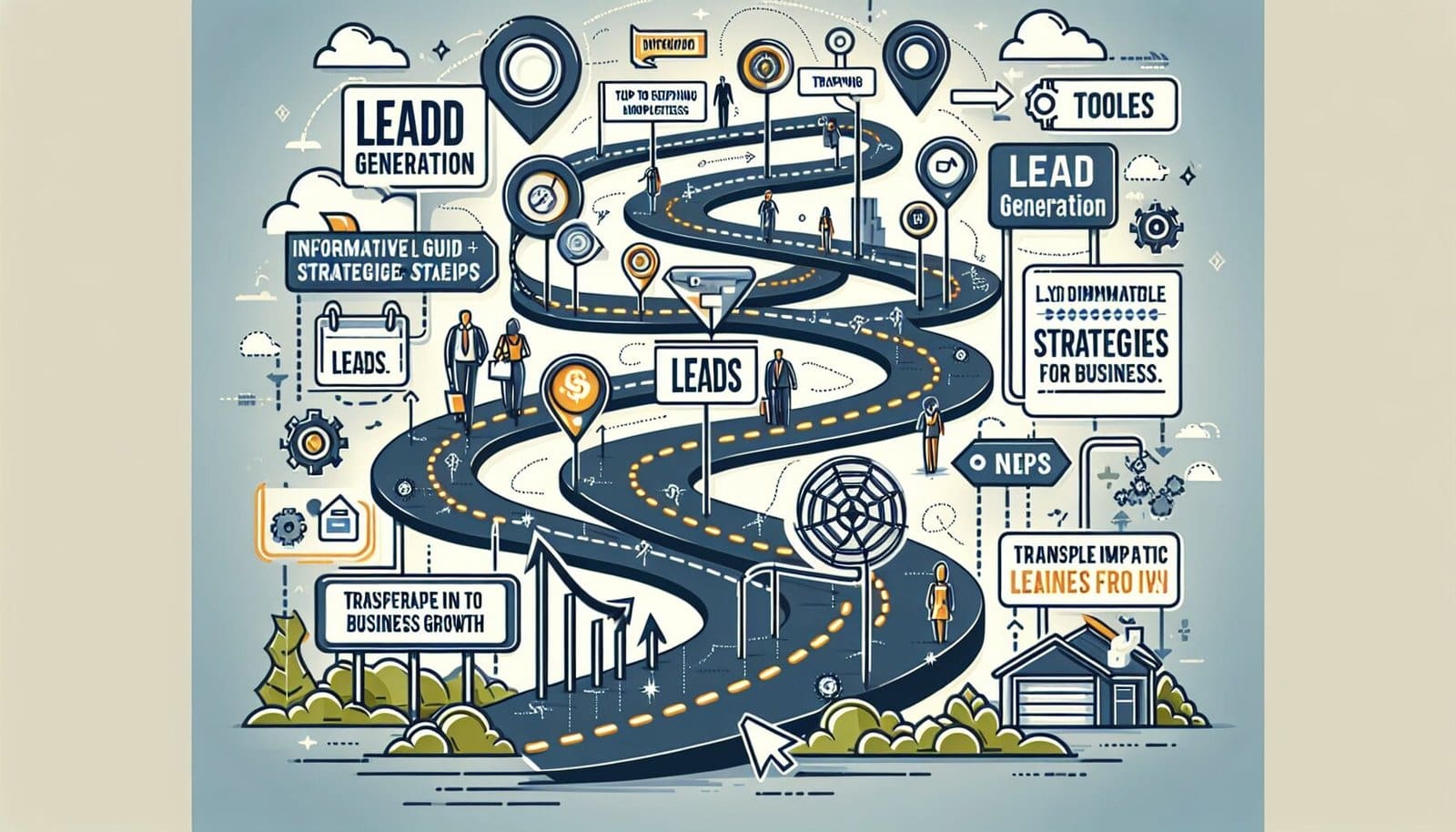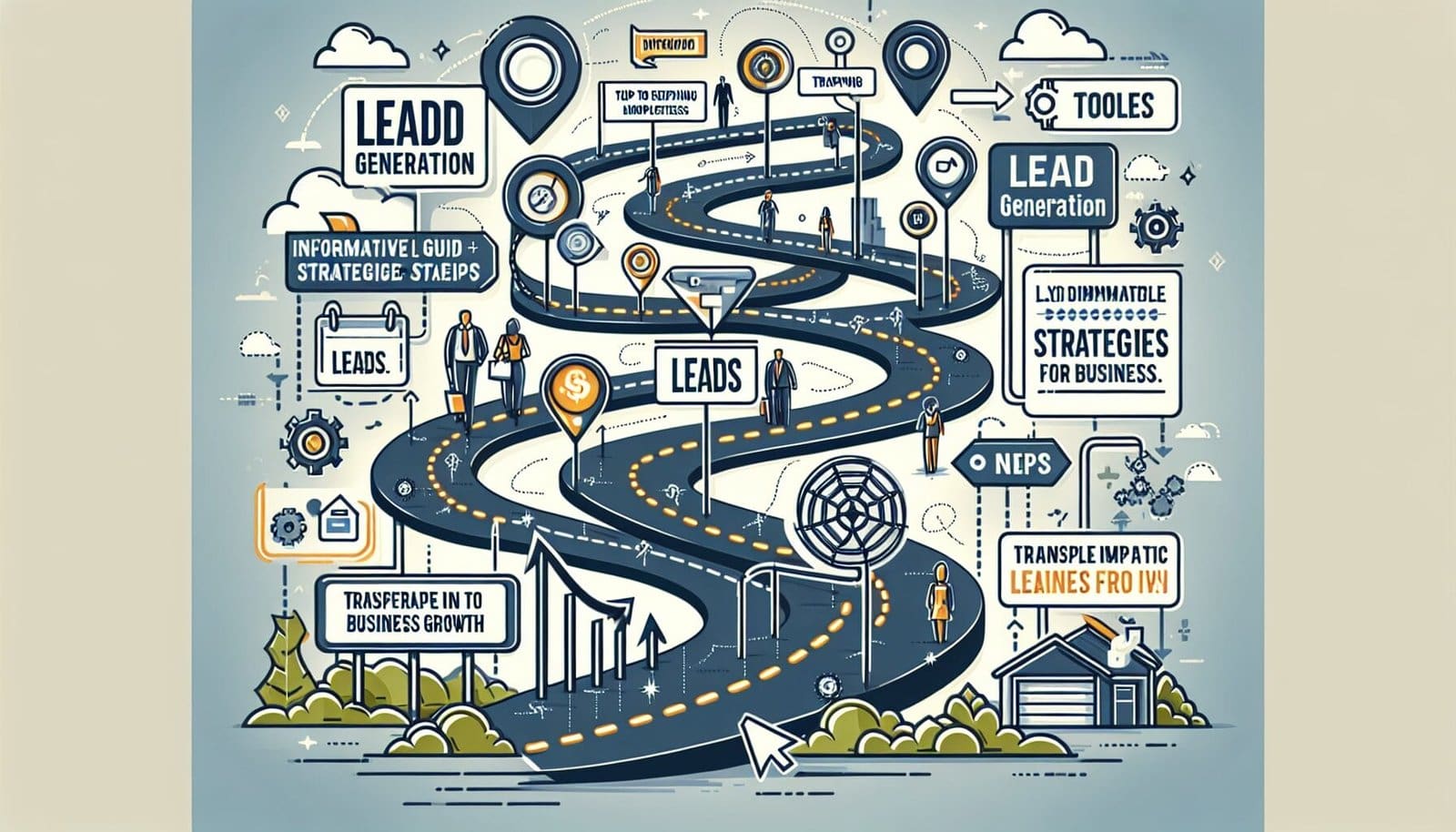Are you ready to take your business to the next level? Look no further! In our article, “The Ultimate Guide: How to Use Lead Generation to Grow Your Business,” we will uncover the secrets to effectively utilizing lead generation to drive growth and success. Whether you're a small startup or an established company, understanding how to generate and nurture leads can make a world of difference in expanding your customer base and increasing sales. Get ready to unlock the power of lead generation and propel your business forward!
Types of Lead Generation
Inbound Lead Generation
Inbound lead generation refers to attracting potential customers through various strategies that focus on creating valuable content and building trust with the audience. This approach involves utilizing tactics such as content marketing, search engine optimization (SEO), and social media marketing to drive organic traffic to your website. By providing valuable information and insights, businesses can position themselves as trusted experts in their industry, resulting in increased brand awareness and a higher likelihood of generating qualified leads.
Outbound Lead Generation
Outbound lead generation involves a more proactive approach, where businesses reach out to potential customers directly. This method typically includes tactics such as cold calling, email marketing, and targeted advertising campaigns. While outbound lead generation may require more effort and resources upfront, it can be an effective strategy for businesses looking to quickly generate leads and drive immediate sales.
Referral Lead Generation
Referral lead generation capitalizes on the power of word-of-mouth marketing. By encouraging satisfied customers to recommend your products or services to others, you can expand your reach and generate high-quality leads. This often involves implementing referral programs or incentivizing customers to refer friends and family. Referral leads have a higher likelihood of converting since they come from trusted sources.
Content Marketing
Content marketing revolves around creating and distributing valuable and relevant content to attract and engage a specific target audience. This can include blog posts, articles, infographics, videos, and more. By consistently delivering valuable content, businesses can establish themselves as thought leaders and build trust with their audience. Content marketing is an effective strategy for lead generation as it allows businesses to position themselves in front of potential customers at various stages of the buyer's journey.
Social Media Marketing
Social media marketing leverages various social media platforms to promote products or services, engage with the audience, and drive traffic to a business's website. Platforms such as Facebook, Instagram, Twitter, LinkedIn, and YouTube provide opportunities to interact with potential customers, share valuable content, and increase brand visibility. By strategically utilizing social media marketing, businesses can generate leads through targeted advertising, organic engagement, and influencer partnerships.
Email Marketing
Email marketing remains a highly effective lead generation strategy, allowing businesses to nurture leads and maintain consistent communication. By building an email list of interested prospects, businesses can deliver personalized and targeted messages to a captive audience. Email marketing campaigns can include newsletters, promotional offers, educational content, and more. With the right segmentation and compelling content, businesses can convert leads into customers through effective email marketing campaigns.
Creating an Effective Lead Capture Strategy
Define Your Target Audience
Before implementing any lead generation strategy, it's crucial to clearly define your target audience. Understanding who your ideal customers are, their needs, pain points, and preferences will allow you to tailor your lead generation efforts for maximum impact. Conduct market research, analyze customer data, and create buyer personas to gain a deep understanding of your target audience segments. This will enable you to craft compelling messages and select the most suitable lead generation channels for reaching and resonating with your desired audience.
Craft a Compelling Value Proposition
A value proposition is a clear statement that highlights the unique benefits and value your products or services offer to customers. It's essential to clearly articulate how your offering solves your target audience's problems and why they should choose you over competitors. A compelling value proposition not only attracts prospective customers but also differentiates your business from others in the market. Ensure your value proposition is concise, communicates a clear value, and resonates with your target audience's needs and aspirations.
Design a High-converting Landing Page
A landing page is a dedicated webpage created specifically to capture leads. It should be designed with a focus on conversion, providing a seamless and user-friendly experience. When designing a high-converting landing page, ensure it has a visually appealing layout, clear and concise messaging, relevant and persuasive call-to-action (CTA) buttons, and a well-optimized lead capture form. Use compelling imagery, persuasive copy, and social proof to build trust and encourage visitors to provide their contact information.
Optimize Forms for Conversion
Lead capture forms play a crucial role in collecting contact information from website visitors. To optimize forms for conversion, keep them simple and straightforward. Only ask for essential information, such as name and email address, to reduce friction and increase completion rates. Design forms to be visually appealing, clearly highlighting the benefits of providing their information. Consider implementing form validation to ensure accurate and valid data. Additionally, optimize the placement, size, and color of CTA buttons to make them visually appealing.

Driving Traffic to Your Lead Capture Page
Search Engine Optimization (SEO)
Search engine optimization is the process of optimizing your website to rank higher in search engine results pages (SERPs). By optimizing your website's content, meta tags, URLs, and other on-page and off-page elements, you can improve your website's visibility and attract organic traffic. Conduct keyword research to identify relevant search terms and incorporate them naturally into your website's content. Additionally, focus on creating valuable and shareable content that attracts backlinks, helping enhance your website's authority and visibility in search engines.
Pay-Per-Click (PPC) Advertising
Pay-per-click advertising allows businesses to display targeted ads on search engines and other platforms. With PPC advertising, businesses bid on keywords and pay when someone clicks on their ad. This method provides immediate visibility and provides businesses with a cost-effective way to drive targeted traffic to their lead capture page. Conduct thorough keyword research and create compelling ad copy to maximize the effectiveness of your PPC campaigns. Continuously monitor and optimize your campaigns based on key performance indicators (KPIs) to drive optimal results.
Social Media Advertising
Social media advertising enables businesses to reach a highly targeted audience based on various demographics, interests, and behaviors. Platforms like Facebook, Instagram, and LinkedIn offer robust advertising features that allow for precise audience targeting. Develop a clear social media advertising strategy, define your target audience, and create visually appealing and engaging ad creatives. Continuously monitor ad performance and make data-driven adjustments to optimize your campaigns for maximum effectiveness.
Influencer Marketing
Influencer marketing involves collaborating with influential individuals in your industry or niche to promote your products or services to their followers. By partnering with influencers who align with your target audience, you can leverage their credibility and reach to generate awareness and trust. Identify relevant influencers, establish meaningful partnerships, and develop creative campaigns that provide value to their audience while promoting your lead capture page. Monitor the performance of your influencer marketing campaigns and track key metrics to measure and optimize your ROI.
Lead Nurturing Strategies
Segmenting Your Leads
Segmenting your leads is crucial for personalized communication and effective lead nurturing. Divide your leads into different segments based on demographics, behavior, interests, and stage in the buyer's journey. This allows you to tailor your messaging and content to resonate with each segment's unique needs and preferences. Utilize marketing automation tools and customer relationship management (CRM) systems to effectively manage and track your segmented leads throughout the nurturing process.
Personalizing Communication
Personalization is key to building meaningful relationships with your leads. Use the data you've collected to create personalized messages that address your leads by their names, acknowledge their specific pain points, and offer relevant solutions. Leverage marketing automation tools to automate personalized email sequences, dynamic content, and targeted offers. By delivering tailored content and messaging, you can increase engagement and foster stronger connections with your leads.
Email Drip Campaigns
Email drip campaigns involve a series of pre-scheduled emails sent to leads over a designated period. These campaigns allow for consistent and automated communication, nurturing leads and moving them further down the sales funnel. Craft a well-planned email sequence that provides value, educates, and drives engagement while directing leads towards your desired conversion actions. Test different subject lines, content formats, and call-to-actions to optimize the effectiveness of your email drip campaigns.
Automating with Marketing Automation Tools
Marketing automation tools streamline and automate repetitive marketing tasks, enabling businesses to scale their lead generation efforts efficiently. These tools can automate lead nurturing workflows, email campaigns, lead scoring, and more. By implementing marketing automation, businesses can effectively manage and track leads, deliver personalized content, and monitor the performance of their campaigns. Explore different marketing automation platforms to find the one that best fits your business needs and integrates seamlessly with your existing systems.

Measuring Lead Generation Success
Defining Key Performance Indicators (KPIs)
Defining key performance indicators (KPIs) is essential for measuring the success of your lead generation efforts. Identify metrics that align with your business goals, such as the number of leads generated, conversion rates, cost per lead, customer acquisition costs, and lifetime value of a customer. Set specific, measurable, attainable, relevant, and time-bound (SMART) goals for each KPI to track and evaluate the effectiveness of your lead generation strategies. Regularly review and analyze these metrics to identify areas for improvement and make data-driven decisions.
Tracking Website Analytics
Tracking website analytics provides valuable insights into user behavior, traffic sources, and the effectiveness of your lead capture page. Utilize tools like Google Analytics to monitor key metrics such as page views, bounce rates, session duration, and conversion rates. By understanding how visitors interact with your website and identifying potential bottlenecks or areas of improvement, you can make data-driven optimizations to enhance your lead generation efforts.
Analyzing Campaign Performance
Regularly analyze the performance of your lead generation campaigns to assess their impact and effectiveness. Track and measure key metrics specific to each campaign, such as click-through rates, conversion rates, cost per acquisition (CPA), and return on investment (ROI). Identify campaigns that have consistently performed well and understand the factors contributing to their success. Conversely, identify underperforming campaigns and analyze potential reasons for their lack of success. Use these insights to refine and optimize future campaigns.
A/B Testing for Optimization
A/B testing, also known as split testing, involves comparing two versions of a webpage, email, or ad to determine which one performs better. By testing different elements, such as headlines, images, call-to-action buttons, or layouts, businesses can identify the optimal combination that maximizes conversion rates. Conduct A/B tests on various aspects of your lead generation strategies to continuously optimize and improve performance. Make incremental changes, collect data, and make informed decisions based on the results to achieve optimal conversion rates.
Lead Generation Tools and Software
Customer Relationship Management (CRM) Systems
Customer relationship management (CRM) systems allow businesses to manage interactions with current and potential customers. These tools provide a centralized database for storing and organizing customer information, including contact details, communication history, and lead scoring. CRM systems enable businesses to track and manage leads, automate lead nurturing workflows, and analyze customer data. Choose a CRM system that suits your business's unique needs and integrates well with your lead generation and marketing automation tools.
Lead Generation Platforms
Lead generation platforms offer a comprehensive set of tools and features to generate, capture, and manage leads. These platforms often include landing page builders, lead capture forms, lead qualification and scoring, analytics, and integration capabilities. Such platforms simplify the lead generation process by providing businesses with a centralized platform to capture, nurture, and convert leads. Choose a lead generation platform that aligns with your business goals, integrates well with your existing systems, and provides the necessary features to drive impactful lead generation campaigns.
Email Marketing Tools
Email marketing tools streamline and automate the process of creating, sending, and analyzing email campaigns. These tools often offer features such as email templates, list segmentation, automated workflows, A/B testing, and analytics. Select an email marketing tool that fits your business needs, making it easy to create engaging email campaigns, segment your leads, and measure the effectiveness of your email marketing efforts. Integration with your CRM system and lead generation platforms is also essential for seamless lead management.
Website Analytics Tools
Website analytics tools provide in-depth insights into user behavior, traffic sources, and conversion rates. Popular tools like Google Analytics, Hotjar, and Crazy Egg allow businesses to track and measure key performance metrics, segment users, and visualize user journeys. These tools help businesses understand how visitors interact with their websites, identify conversion bottlenecks, and make data-driven optimizations. Implement a website analytics tool that suits your business needs and integrate it with your lead generation and marketing automation systems for comprehensive data analysis.
Effective Lead Generation Tactics
Offering Valuable Content as Lead Magnets
One effective tactic for lead generation is offering valuable content as lead magnets. Lead magnets are free resources, such as ebooks, whitepapers, guides, or templates, that provide value to your target audience. By offering valuable content in exchange for contact information, businesses can attract and capture leads. Create compelling and relevant lead magnets that address your audience's pain points, positioning your business as a trusted source of knowledge and expertise. Promote your lead magnets through various channels, such as your website, social media, and email campaigns, to maximize their reach and impact.
Hosting Webinars or Workshops
Hosting webinars or virtual workshops is an effective way to engage with your target audience and establish thought leadership. Webinars allow you to deliver valuable and educational content while providing an interactive platform for participants to ask questions and engage with your business. Promote your webinars through email campaigns, social media, and your website to attract interested participants. During the webinar, provide valuable insights, address common challenges, and offer actionable takeaways. Leverage the opportunity to capture leads by requiring participants to register and provide their contact information.
Running Contests or Giveaways
Contests and giveaways are a fun and engaging tactic to capture leads and create excitement around your brand. Choose a relevant and desirable prize that aligns with your target audience's interests. Promote the contest or giveaway through social media, email campaigns, and your website. Require participants to provide their contact information to enter or participate, allowing you to generate leads and build your email list. Ensure you have a clear plan for following up with participants post-contest to nurture and convert leads into customers.
Using Social Proof
Social proof is a powerful psychological principle that leverages the influence of others to affirm the value and credibility of your business. Incorporate social proof elements, such as customer testimonials, case studies, reviews, and social media mentions, into your lead generation efforts. Highlight positive experiences and results that previous customers have had with your products or services. By showcasing social proof, you can build trust, improve conversion rates, and persuade potential customers to take action.
Leveraging Influencer Partnerships
Influencer partnerships can help amplify your lead generation efforts by tapping into an influencer's existing audience and credibility. Identify influencers in your industry or niche who have a significant following and align with your target audience. Engage with influencers by offering them access to your products or services or proposing mutually beneficial partnerships. Collaborate on content creation, co-host events, or launch joint marketing campaigns to promote your lead capture page and generate qualified leads. Ensure the collaboration is authentic and delivers value to the influencer's audience while aligning with your lead generation goals.
Optimizing Lead Conversion
Creating Compelling Call-to-Actions (CTAs)
Call-to-actions (CTAs) are essential elements in guiding leads to take the desired conversion actions. A compelling CTA should clearly communicate the value proposition and convey a sense of urgency. Use action verbs and persuasive language to encourage visitors to take the next step. Place CTAs strategically on your website and landing pages, ensuring they stand out and are easily clickable. A well-designed and persuasive CTA can significantly impact lead conversion rates.
Utilizing A/B Testing for CTA Optimization
To optimize the effectiveness of your CTAs, utilize A/B testing. Test different variations of CTA buttons, colors, text, placement, and wording to identify the combination that drives the highest conversion rates. A/B testing allows you to make data-driven decisions based on the performance of each variation. Continuously refine and optimize your CTAs based on the insights gained from A/B testing to maximize lead conversion.
Providing Clear and Relevant Benefits
Clearly communicate the benefits that potential customers will receive by providing their contact information and engaging with your business. Highlight the value they will gain from your offerings, whether it is access to exclusive content, personalized insights, discounts, or solutions to their pain points. By demonstrating the specific benefits and relevance, you can entice leads to convert. Emphasize the unique selling points of your products or services and clearly outline why choosing your business will impact their lives or solve their problems.
Reducing Friction in the Conversion Process
Minimize the friction that leads may encounter when trying to convert. Streamline your lead capture process by eliminating unnecessary steps or requirements in your lead capture forms. Design a simplified and intuitive user experience that guides leads seamlessly through the conversion process. Ensure your website and landing pages load quickly and are mobile-friendly. By reducing friction, you increase the likelihood of leads completing the conversion process and becoming customers.
Maximizing Lead Generation ROI
Lead Scoring and Prioritization
Implement a lead scoring system to prioritize your leads and focus your efforts on those most likely to convert. Assign values to various lead characteristics and behaviors, such as demographics, engagement levels, and actions taken on your website. Based on the lead score, prioritize your follow-up and lead nurturing strategies, dedicating more resources to leads with higher scores. This approach ensures that your sales and marketing teams are focused on leads with the most potential, optimizing your lead generation ROI.
Improving Contact and Sales Team Alignment
Effective collaboration and alignment between your marketing and sales teams are crucial for maximizing lead generation ROI. Encourage regular communication and feedback between the two teams to ensure the seamless transfer of leads and alignment of goals and strategies. Implement lead handoff processes and establish clear criteria for when leads should be passed from marketing to sales. Provide sales teams with timely and relevant information about leads to enable personalized and effective follow-up, maximizing the chances of conversion.
Implementing Marketing and Sales Automation
Marketing and sales automation tools streamline and optimize lead generation and conversion processes. Automating repetitive tasks, such as lead nurturing workflows, email follow-ups, and lead qualification, frees up valuable time and resources for your teams. Implement marketing and sales automation tools that integrate seamlessly with your CRM system and lead generation platforms. Leverage these tools to automate processes, personalize communication, and ensure consistent and timely follow-up with leads, maximizing the efficiency and effectiveness of your lead generation efforts.
Tracking and Analyzing ROI of Lead Generation Efforts
Regularly track and analyze the return on investment (ROI) of your lead generation efforts to measure their overall success and refine your strategies. Calculate the cost per lead, cost per acquisition, and lifetime value of a customer to understand the financial impact of your lead generation activities. Monitor and evaluate the performance of different lead generation channels and campaigns to identify the most effective and efficient strategies. Use these insights to allocate resources strategically and optimize your lead generation ROI.
Common Lead Generation Mistakes to Avoid
Relying Solely on Cold Calling
Cold calling can be an effective lead generation tactic, but relying solely on it can hinder your results. Cold calling is time-consuming, expensive, and may not yield significant results. Instead, focus on implementing a comprehensive lead generation strategy that utilizes multiple channels and tactics. By leveraging different approaches, such as inbound marketing, social media advertising, and content marketing, you can reach a wider audience and generate a steady stream of qualified leads.
Neglecting to Segment Leads
Neglecting to segment leads can result in ineffective and generic communication that fails to resonate with your audience. Segmenting leads allows you to craft personalized messages and tailor your content to address specific pain points and preferences. Take the time to understand your leads' demographics, interests, and behaviors, and create strategic segments for more targeted communication. Personalization is vital for building relationships and maximizing the chances of conversion.
Failing to Follow Up in a Timely Manner
Failing to follow up with leads promptly can cause them to lose interest and seek solutions elsewhere. Ensure your sales and marketing teams have a well-defined follow-up process that includes timely responses to inquiries and leads. Implement lead nurturing workflows, automated email sequences, and reminders to ensure no leads fall through the cracks. Prompt and relevant follow-up increases the likelihood of conversion and demonstrates your commitment to solving your leads' problems.
Overlooking the Importance of Lead Qualification
Overlooking lead qualification can result in wasted resources on leads that are not a good fit for your business. Implement a lead qualification system to assess the quality and readiness of leads before investing significant time and effort in nurturing them. Define lead qualification criteria and ensure your marketing and sales teams are aligned on what constitutes a qualified lead. Prioritize leads with the highest potential for conversion to maximize your resources and improve lead generation ROI.
In conclusion, lead generation is a vital process for business growth. By utilizing various lead generation strategies, optimizing conversions, nurturing leads, and tracking ROI, businesses can generate a consistent stream of qualified leads and convert them into loyal customers. Avoid common lead generation mistakes, segment your leads, and leverage the power of automation and analytics to drive optimal results. With a comprehensive and well-executed lead generation strategy, your business can thrive and achieve long-term success.









